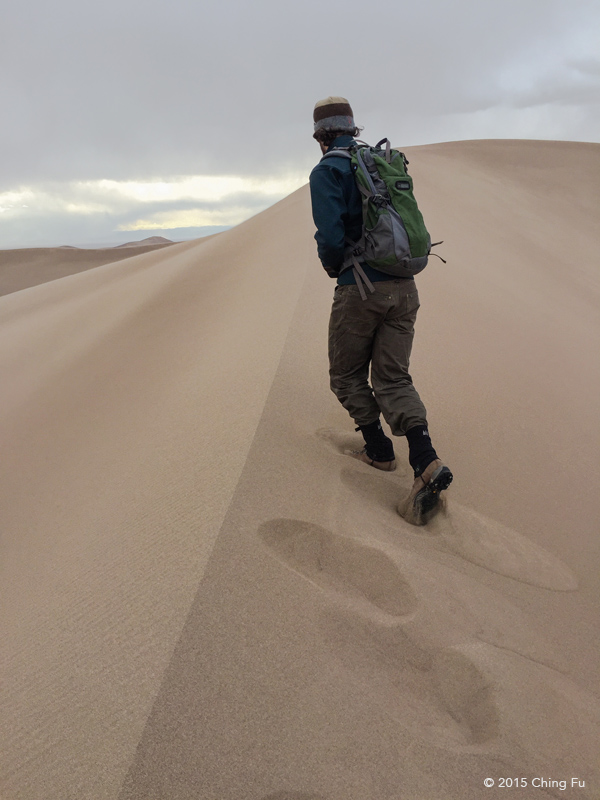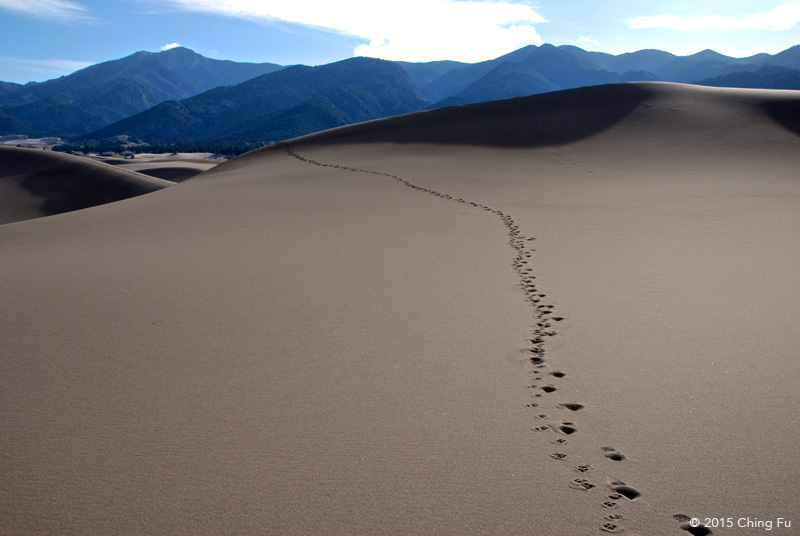The Great Sand Dunes: Tips For A Great Time
“Water, water, water…There is no shortage of water in the desert but exactly the right amount, a perfect ratio of water to rock, water to sand, insuring that wide free open, generous spacing among plants and animals, homes and towns and cities, which makes the arid West so different from any other part of the nation. There is no lack of water here unless you try to establish a city where no city should be.”
The Great Sand Dunes National Park look so out of place sitting in the middle of the San Luis Valley with the snow covered Sangre de Cristo Mountains as its backdrop on the eastern side. On our drive from Salida to Crestone, Jerud pointed out the sand dunes to me; from afar you could see the land turn smooth at the foot of the mountains. I was very excited to see the Great Sand Dunes and knew it would be a unique experience. But I wasn’t prepared for how spellbound I would be by them.
It wasn’t until 2004 that the Great Sand Dunes became a national park and national preserve. From 1932 until then the Great Sand Dunes was a national monument. The Great Sand Dunes are the tallest sand dunes in North America; Star Dune is the tallest standing at 755 ft. and High Dune is the second tallest at 699 ft. High Dune is the more accessible dune and it’s about a 3-mile roundtrip hike from the main dune trailhead parking lot to the peak. Star Dune is further pass High Dunes and is in the wilderness section of the national park. Of the 330 sq. miles of deposited sand, 11% of it is sand dunes, the other 53% of the sand deposit is sand sheet and the last 36% is made up of low-lying salt-encrusted plains.
It was gently snowing when we arrived the park, but none of it was sticking. The wintery mix and it being late in the afternoon kept the sand dunes fairly empty. Since dogs are actually allowed to hike the sand dunes up to where the wilderness boundary starts, we brought Tybee and Tyki with us on our first hike. We didn’t go to far for Tybee’s sake, but we did make it to the top of the first sand dune. I’m pretty sure it meant more to me that Tybee got to experience the Great Sand Dunes than it meant to her. To her it was like being at the beach, which is one of her favorite things, there was even the Medano Creek for her to splash in. She hiked up the dunes, stuck her nose into the sand to sniff, and would occasionally dig into the sand like she does at the beach. It was extremely windy that afternoon and the dogs were covered in a layer of sand. We brought Tybee back to the truck and went out to the sand dunes again with only Tyki this time (he always has too much penned up energy).
Our non-mesh waterproof hiking boots came in handy for crossing Medano Creek, which wasn’t as high as it gets during the summer when all the snow melts from the Sangre de Cristo Mountains. Our other smart move was that we wore gaiters, which did an excellent job keeping the sand out of our boots. On our second hike we headed up towards High Dunes. The wind picked up as we got higher and at times we would stop and turn out backs towards the wind so we wouldn’t get blasted with sand. The wind moved the sand along like creeping shadows. Hiking along the crest of a sand dune is picking one side of the dune to walk on and then slipping sideways downhill with each step. From the peak of High Dunes you could see wave after wave of dunes below, spreading out far into the horizon.
Jerud and I decided that we would stay the night at the Piñon Flats Campground inside the park and pay the $20 because of its proximity to the dunes. Our campground goal had been that we would only pay for an RV site if it had hookups so that we could maximize our stay and get chores done. I didn’t really expect Piñon Flats Campground to be as full as it was this early in the season. The first loop was pretty much filled up and the few sites that were available weren’t long enough to fit both the truck and RV. We ended up finding a pull-through spot in the second loop. It was at this site that we accidentally ripped off our gray water dump valve. There is a dump station area inside the park and it also has fresh water, so we filled our fresh water tank on our way out of the park the next day.
Early the next morning Tyki and I headed back out to the dunes. Medano Creek had a layer of freeze on top and we had the dunes all to ourselves. I can’t do the experience justice by trying to explain how special it was to be at the dunes that early in the morning and have the whole place to ourselves. Take a moment and imagine this: It was absolutely silent, the wind wasn’t blowing, and there wasn’t any traffic on the park roads. Everything was still. The wind during the night had wiped most of the dunes clean of the previous day’s footprints. The sand dune crests were sharp and crisp and the shadows were dark and long. The dunes looked so smooth and silky, like someone had taken a large paintbrush over each dune. I hadn’t planned to be out for very long, but the urge to keep walking and exploring what was further beyond was strong. Standing amidst the dunes, I couldn’t take my eyes off them and I didn’t want to leave. This powerful desire to just sit and stay for just a bit longer surfaced.
Disclosure: This post contains affiliate links. Please read our full disclaimer.
Tips
- Tyki’s pads got irritated by the sand during our longer hikes. Perhaps dog booties are something good to bring for your dog if you plan to hike the sand dunes for long. The sand gets up to 140* degrees during the summer so you will to leave your dog at a safe and cool place.
- Hike the sand dunes early in the morning to miss the crowds, and to see cool shadows.
- The fresh water hose at the dump station doesn’t have threads on it; make sure you have a water thief to be able to fill your RV fresh water tank easily.
- Waterproof boots and gaiters will keep your feet dry and free of sand.
- Bring sunglasses to keep the sand out of your eyes when the wind gets strong.
- Bring poop bags with you if you go hiking with your dog so you don’t leave turds on the dunes. Don’t forget to carry out the full bags out with you.
- The park is open 24/7. This means that you can do night hikes on the dunes or on other trails in the park.











